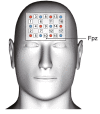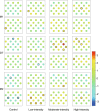Effects of different exercise intensities on prefrontal activity during a dual task
- PMID: 35906385
- PMCID: PMC9338235
- DOI: 10.1038/s41598-022-17172-5
Effects of different exercise intensities on prefrontal activity during a dual task
Abstract
The effects of physical exercise on cognitive tasks have been investigated. However, it is unclear how different exercise intensities affect the neural activity. In this study, we investigated the neural activity in the prefrontal cortex (PFC) by varying the exercise intensity while participants performed a dual task (DT). Twenty healthy young adults performed serial subtraction while driving a cycle ergometer. Exercise intensity was set to one of three levels: low, moderate, or high intensity. We did not find any significant change in PFC activity during DT under either the control (no exercise) or low-intensity conditions. In contrast, we observed a significant increase in PFC activity during DT under moderate- and high-intensity conditions. In addition, we observed complex hemodynamics after DT. PFC activity decreased from baseline after DT under the control condition, while it increased under the low-intensity condition. PFC activity remained higher than the baseline level after DT under the moderate-intensity condition but returned to baseline under the high-intensity condition. The results suggest that moderate-intensity exercise with a cognitive load effectively increases PFC activity, and low-intensity exercise may increase PFC activity when combined with a cognitive load.
© 2022. The Author(s).
Conflict of interest statement
The authors declare no competing interests.
Figures



Similar articles
-
Changes in Oxyhemoglobin Concentration in the Prefrontal Cortex and Primary Motor Cortex During Low- and Moderate-Intensity Exercise on a Cycle Ergometer.Adv Exp Med Biol. 2017;977:241-247. doi: 10.1007/978-3-319-55231-6_33. Adv Exp Med Biol. 2017. PMID: 28685452
-
Cerebral Oxygenation Reserve: The Relationship Between Physical Activity Level and the Cognitive Load During a Stroop Task in Healthy Young Males.Int J Environ Res Public Health. 2020 Feb 21;17(4):1406. doi: 10.3390/ijerph17041406. Int J Environ Res Public Health. 2020. PMID: 32098221 Free PMC article.
-
Affect during incremental exercise: The role of inhibitory cognition, autonomic cardiac function, and cerebral oxygenation.PLoS One. 2017 Nov 1;12(11):e0186926. doi: 10.1371/journal.pone.0186926. eCollection 2017. PLoS One. 2017. PMID: 29091915 Free PMC article.
-
Prefrontal Cortex Oxygenation During Endurance Performance: A Systematic Review of Functional Near-Infrared Spectroscopy Studies.Front Physiol. 2021 Oct 26;12:761232. doi: 10.3389/fphys.2021.761232. eCollection 2021. Front Physiol. 2021. PMID: 34764885 Free PMC article. Review.
-
Evaluation of the transient hypofrontality theory in the context of exercise: A systematic review with meta-analysis.Q J Exp Psychol (Hove). 2022 Jul;75(7):1193-1214. doi: 10.1177/17470218211048807. Epub 2021 Oct 11. Q J Exp Psychol (Hove). 2022. PMID: 34523365
Cited by
-
Physical activity and self-efficacy in college students: the mediating role of grit and the moderating role of gender.PeerJ. 2024 May 24;12:e17422. doi: 10.7717/peerj.17422. eCollection 2024. PeerJ. 2024. PMID: 38803579 Free PMC article.
-
Prefrontal cortex activation during daily movements and its association with clinical symptoms in knee osteoarthritis.Osteoarthr Cartil Open. 2025 Apr 24;7(3):100615. doi: 10.1016/j.ocarto.2025.100615. eCollection 2025 Sep. Osteoarthr Cartil Open. 2025. PMID: 40529109 Free PMC article.
-
Effects of Dual Tasks Including Gum Chewing on Prefrontal Cortex Activity.Adv Exp Med Biol. 2024;1463:153-158. doi: 10.1007/978-3-031-67458-7_26. Adv Exp Med Biol. 2024. PMID: 39400816
-
Experience sampling method studies in physical activity research: the relevance of causal reasoning.Int J Behav Nutr Phys Act. 2025 Mar 5;22(1):28. doi: 10.1186/s12966-025-01723-w. Int J Behav Nutr Phys Act. 2025. PMID: 40045348 Free PMC article.
-
Effects of exercise intensity on the reactive astrocyte polarization in the medial prefrontal cortex.Phys Act Nutr. 2023 Jun;27(2):19-24. doi: 10.20463/pan.2023.0014. Epub 2023 Jun 30. Phys Act Nutr. 2023. PMID: 37583068 Free PMC article.
References
MeSH terms
LinkOut - more resources
Full Text Sources
Medical
Miscellaneous

